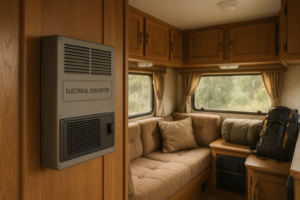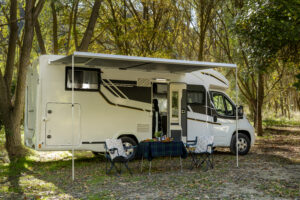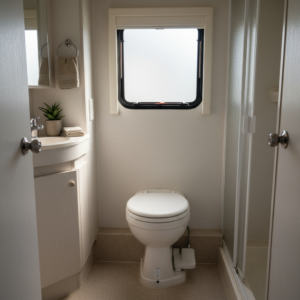
Leaky RV Roof? Here’s the Best Way to Find and Repair the Leak (Before It Ruins Your RV!)
Table of Contents
There’s nothing like waking up in your motorhome to the sound of rain—until that comforting patter turns into a cold drip on your forehead. A leaky RV roof isn’t just annoying. If left unchecked, it can quietly wreak havoc on your rig. From water damage in an RV—like rotting wood and mold—to ruined electronics and sagging ceilings, roof issues don’t wait.
The good news? With the right tools, roof sealants, and a little know-how, you can fix RV roof leaks before they turn into costly repairs. Whether you’re the DIY type or prefer professional RV service, here’s everything you need to know to stop the drip and keep your camper roof in good condition.
Why Ignoring a Leaky RV Roof Is a Costly Mistake
It’s tempting to put off repairs when the damage isn’t glaringly obvious. But even a small roof leak can allow water to seep into insulation, degrade roof materials, and create the perfect environment for mold. Ignoring these signs of trouble may force you into replacing your RV’s roof entirely.
Leaks also hurt your wallet when it’s time to sell. Visible water damage can slash resale value, and a compromised roof structure poses safety risks.
Bottom line: If you’ve spotted a leak in an RV, don’t wait. Repair your RV roof before the issue spreads.
Tools and Materials You’ll Need
Having the right tools and materials makes repairing RV leaks much easier. Here’s a starter kit:
- RV-specific sealant (like Dicor Self-Leveling Lap Sealant or Eternabond Tape, or similar products available)
- Soft-bristle brush for cleaning the roof
- Denatured alcohol to clean the surface
- Putty knife (to remove any old caulk or sealant bead)
- Hose for inspection testing
- Safety harness (essential on sloped roof types)
- UV protectant spray for leak prevention
- Nitrile gloves & microfiber rags
- Moisture meter (for detecting hidden water damage)
Skip general-purpose silicone caulk for your RV’s roof membrane (EPDM, TPO, or fiberglass). Use roof sealants made for your specific RV roof type to ensure a long lifespan.
How to Fix a Leaky RV Roof: A Step-by-Step Guide
1. Find the Leak
Start inside your camper: look for stains, soft spots, bubbling wallpaper, or musty smells. Then head up and inspect the roof regularly, especially around seams, skylights, AC units, vents, and edges.
Still unsure? Run a hose in sections. Have someone inside look for drips—this simple inspection can save big money.
2. Apply a Temporary Fix (If You’re on the Road)
Sometimes a leak shows up mid-trip, and you’ve got to act fast.
- For Punctures: Clean the damaged area thoroughly, then apply a high-quality repair tape like EternaBond or Tedlar. These tapes offer a permanent fix when applied correctly. For added protection, apply self-leveling lap sealant around the edges of the patch to prevent lifting over time. This quick and easy emergency repair can be done with materials commonly found at most RV supply stores.
- For Cracks or Gaps: Clean the surface and apply RV sealant generously. Smooth it out using a putty knife or a disposable 2-inch brush. Allow the sealant to cure for at least 24 hours before driving at highway speeds to ensure proper adhesion and prevent it from blowing off.
3. Clean and Prep the Area
Once you’re ready for the permanent fix, prep is everything. Use a soft-bristle brush to remove debris. Wipe the area with denatured alcohol to ensure the new sealant sticks. If there is old, cracked sealant in the way, gently scrape it off with a putty knife.
4. Make the Repair
Here’s where it all comes together:
- Cracked Sealant: Apply RV sealant in overlapping layers, creating a thick, watertight barrier. Don’t rely on gravity to spread it evenly – use a putty knife or a disposable 2-inch brush to gently tool it into place for full coverage and proper adhesion.
- Leaky Vents or AC Units?: For vents, remove the old sealant, apply butyl tape under the flange, and reseal the edges with self-leveling sealant. For AC units, do not use tape or sealants. Instead, check that the mounting bolts are secure and the foam gasket is compressed to about 50%. If the AC is still leaking, the gasket may need replacement. If there’s damage to the membrane underneath, remove the AC, repair the roof with appropriate repair tape like EternaBond or Tedlar, and install a new gasket before reinstalling the unit.
- Punctures or Holes: Cut a piece of the repair tape at least 2 inches wider than the hole in every direction. Press it down firmly and smooth out any air bubbles.
Let the repair cure thoroughly before testing.
5. Test It
Once the repair has cured (usually within 24 hours), re-run your hose test. Move slowly over the repaired area. No drips? You’re in the clear.
Tip: If you’re working alone, place a small lawn sprinkler on top of the AC unit and let it run while you check inside for leaks.
6. Prevent Future Leaks
Roof maintenance is the real secret here.
- Inspect seals and seams every few months, especially after storms or hail.
- Apply a UV protectant after each scrubbing to slow down wear and cracking.
- Schedule a professional roof inspection at least once a year, especially if your RV is stored outdoors.
For mobile service and long-term peace of mind, Good Sam RV ProCare can help with regular checkups and full RV roof repair services, right at your doorstep.
Pro Tips and Cost-Saving Hacks
Catching a roof leak early is great, but preventing one altogether? Even better. Whether you’re deep into a repair or just keeping your rig road-ready, these savvy tips can save you money, time, and a whole lot of frustration down the road.
- Use a FLIR Camera or UV Flashlight After Dark: Hidden pinholes and hairline cracks can go unnoticed in daylight but become visible under the right tools. A FLIR camera adapter for your phone is an affordable option that detects temperature differences your eyes can’t. Alternatively, a UV flashlight can make tiny flaws glow, helping you catch issues before they turn into leaks.
- Keep an Emergency Roof Repair Kit Onboard: Equip it with essentials like EternaBond tape, RV-specific sealant, nitrile gloves, a can of denatured alcohol, microfiber shop towels, and a putty knife. Proper surface prep is critical for a lasting repair, especially when you’re far from a service center and need to fix storm or impact damage quickly.
- Don’t Over-Tighten Screws on Roof-Mounted Gear: Solar panel brackets, vent covers, and racks should be snug but not cranked down. Overtightening can crush rubber gaskets or crack your roof membrane, both of which can invite leaks.
- Inspect After Heavy Weather and Travel: Hail, high winds, falling debris, or long drives can damage seals and seams – even without visible tears. Do a quick walk-around after storms and every trip or extended drive. Issues can develop on the road, and without checking, you might never know.
- Use a Digital Moisture Meter Inside Your RV: These inexpensive tools can detect hidden water behind walls or under floors, especially around ceiling corners and roof vents. Catching that early can save you from mold remediation later.
- Avoid Walking on Unsupported Roof Sections: Some RVs have weight-bearing walkable roofs, but many don’t. If you’re unsure, use a wide board to spread your weight. A misstep could crack the membrane, or worse, punch through plywood weakened by water.
- Don’t Ignore Roof Sag: Sagging roofs often indicate structural damage. If you notice sagging, call a pro immediately.
- Apply UV Protectant to Roof Surfaces After Each Scrubbing: This helps prevent the sealants from drying out and cracking under constant sun exposure. It can also extend your roof’s lifespan.
- Time Your Repairs with Routine Maintenance: If you’re already planning a cleaning, tire check, or tank flush, add a roof inspection and touch-up to the list. Combining maintenance helps you stay on schedule and avoid separate service calls.
- Don’t Skimp on Quality Materials: Bargain-bin sealant might save you a few bucks now, but it can cost hundreds in damage later. Stick to trusted RV-specific brands that bond well and stay flexible over time.
- Store Your RV with a Breathable Cover: If you’re parked for the season, a well-fitted, breathable RV cover helps block UV rays and keep debris off your roof while preventing trapped moisture, a major cause of mildew and slow leaks.
Photograph Your Roof Before and After Trips: A quick smartphone pic can serve as a helpful “before” picture if you spot damage later. It’s especially useful for insurance claims or manufacturer warranty issues.
When to Call in a Pro
Let’s be honest, some repairs just aren’t worth the risk. If you’re crawling around with a sealant gun while your ceiling sags and water seeps near the breaker panel, it’s time to step back and call in the experts.
Here’s when you should definitely call a pro:
- Water is Leaking Near Electrical Components or Wiring: This is a serious fire and shock hazard and should never be a DIY job.
- The Roof Feels Soft or Saggy in Multiple Spots: That’s usually a sign of waterlogged insulation or even rot, which requires repairs that go beyond sealant and tape.
- You’ve Tried More Than Twice, and the Leak Keeps Coming Back: Persistent leaks often mean the damage is deeper than it looks on the surface.
- You’re Seeing Bubbling or Delaminated Interior, Exterior, and Bonded Sidewalls: This usually means water has been entering and spreading for a while.
- You Notice Discoloration or Mold around Roof Seams or Ceiling Panels: Mold spreads quickly and can pose health risks.
- There’s Visible Structural Separation or Cracking at Joints or Edges: This could indicate shifting, warping, or weakening of the roof frame itself.
- You Don’t Have a Safe Place to Work: Sloped or wet roofs are dangerous. If you’re unsure about your footing or working at height, don’t risk it.
If you’d rather not climb up yourself, Good Sam RV ProCare’s RV roof repair services include mobile inspections, resealing, and full leak repairs—bringing expert care right to your campsite or driveway.
Conclusion
When it comes to camper roof leak repair, speed is everything. A small drip today can turn into a serious and expensive problem tomorrow. Whether you’re tackling a simple patch job or dealing with structural damage, acting early saves you time, money, and a whole lot of stress.
And if the job looks a little too big to take on yourself, don’t sweat it. Good Sam RV ProCare brings trusted, mobile RV roof repair services right to your location, so you can get back to what really matters: enjoying the open road.
Got a leak right now? Don’t wait. Let the Good Sam RV ProCare team handle it fast, right where you are.
Frequently Asked Questions (FAQs)
Can I use Flex Seal on my RV roof?
It might work short term, but it’s not designed for RV roof types like EPDM or fiberglass. Use RV-specific roof sealants instead.
How much does professional RV roof repair cost?
Professional RV repair costs can vary widely, but typical basic repairs range from $300–$1,500, depending on the damage.
How often should I inspect my RV roof?
Inspect the roof at least every three months and after storms. Regular inspection is the best leak prevention strategy.


